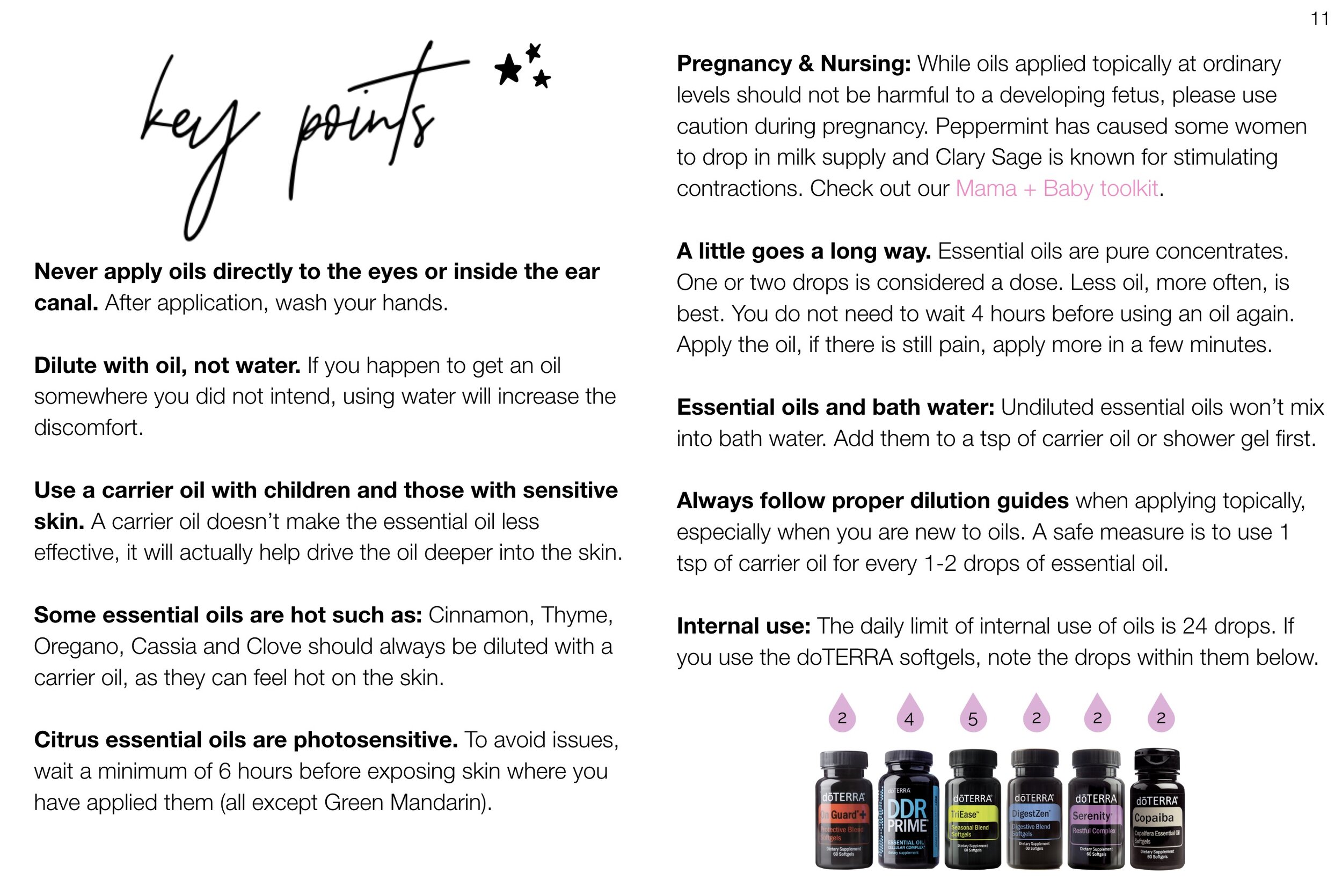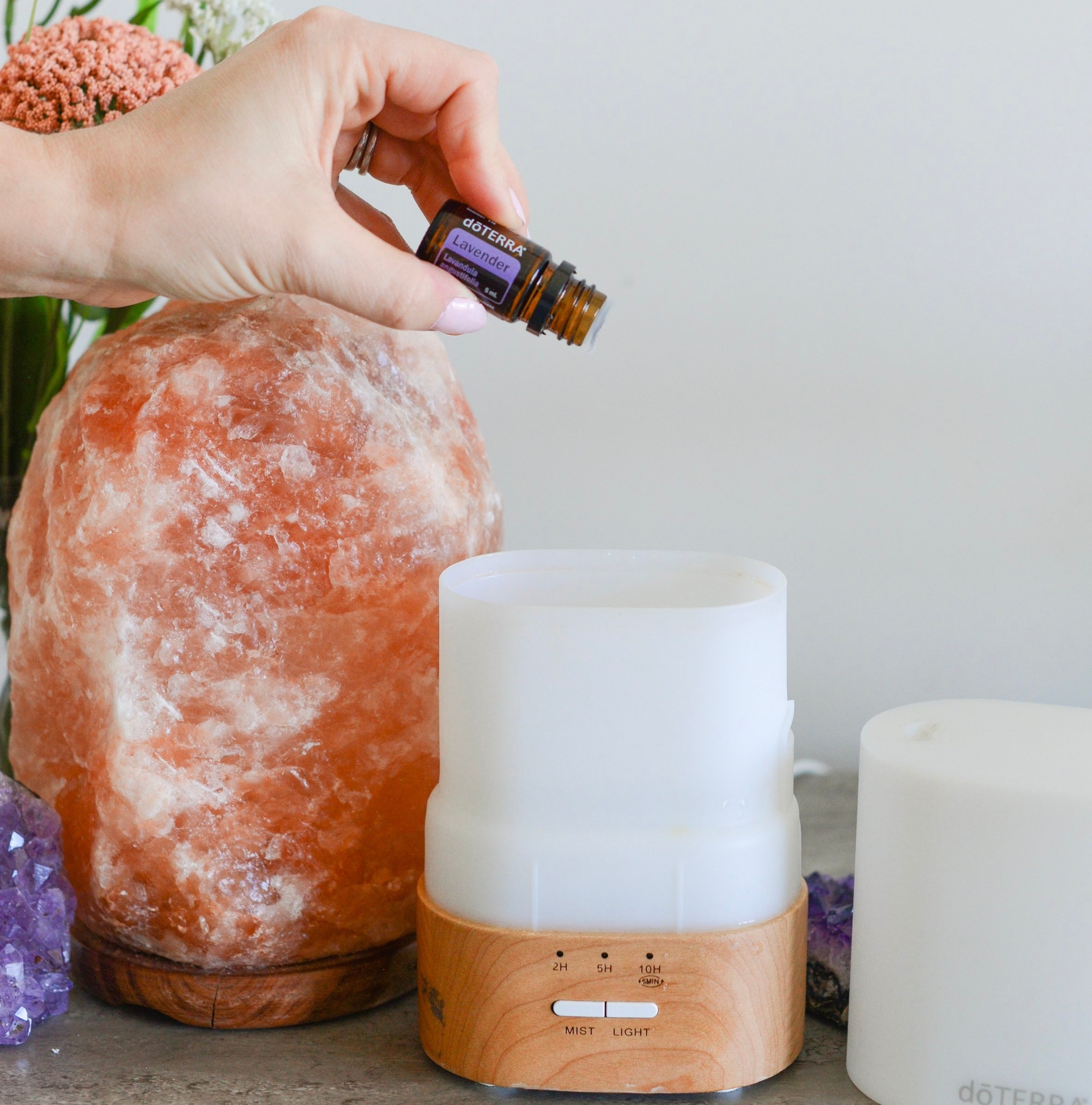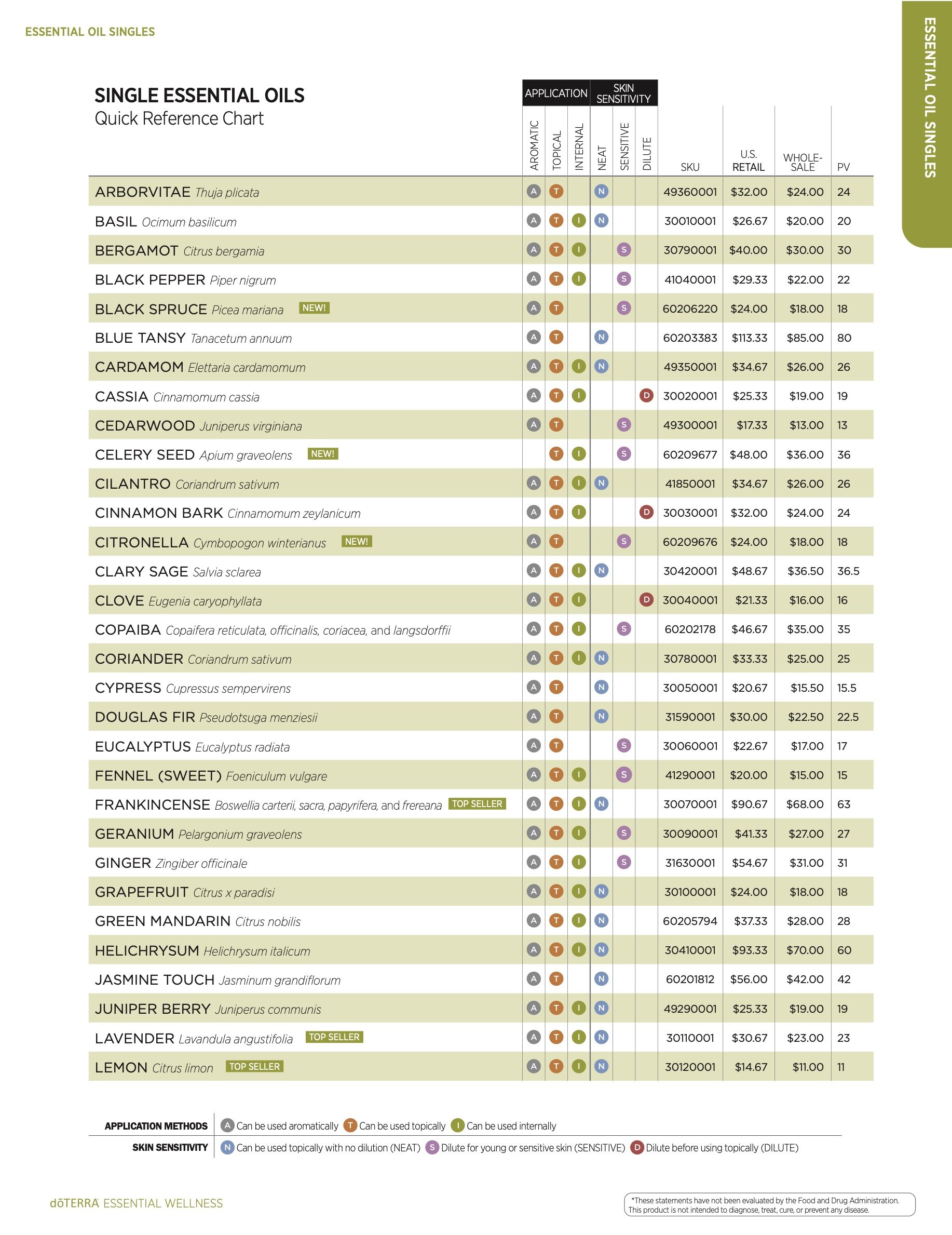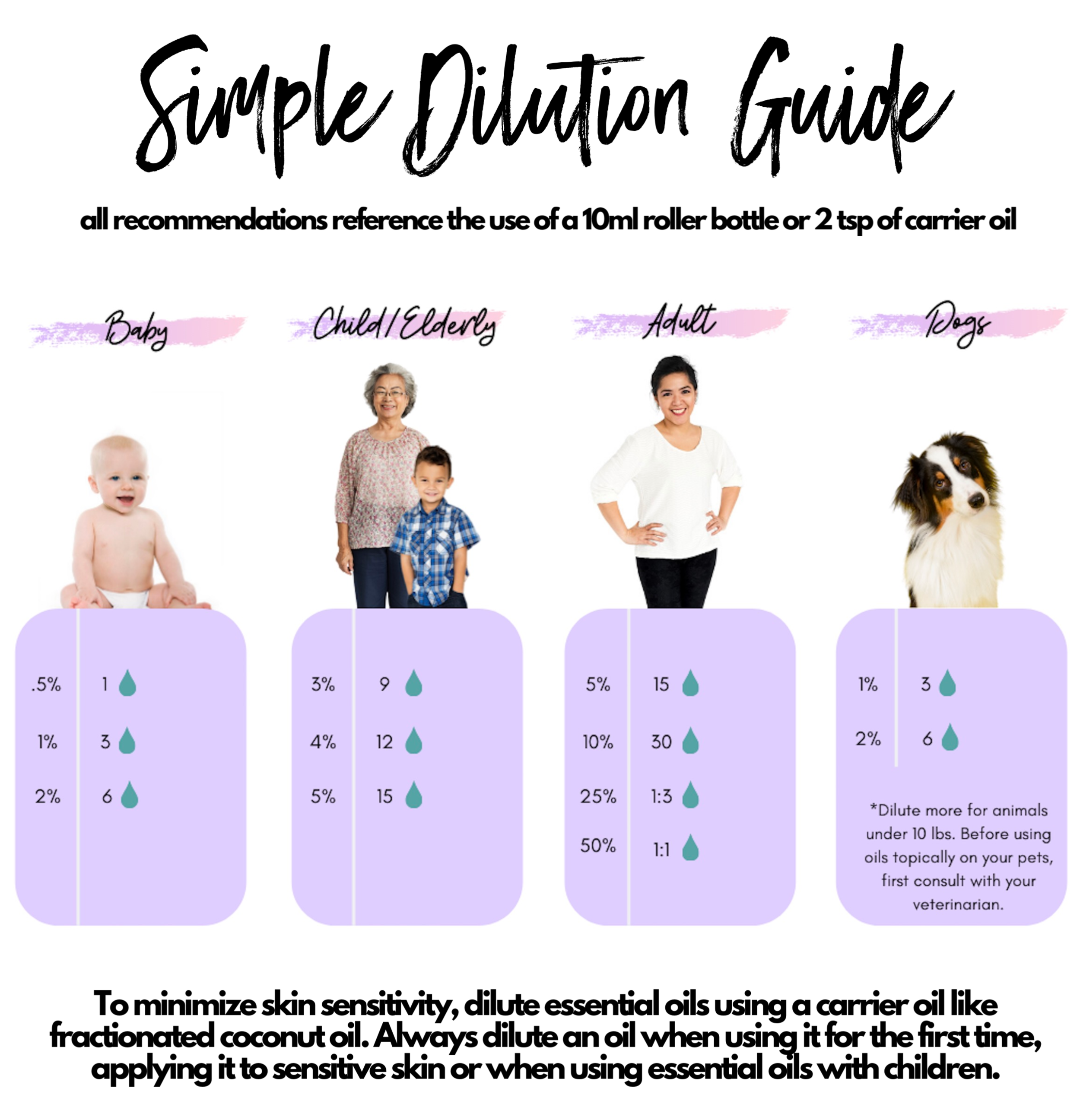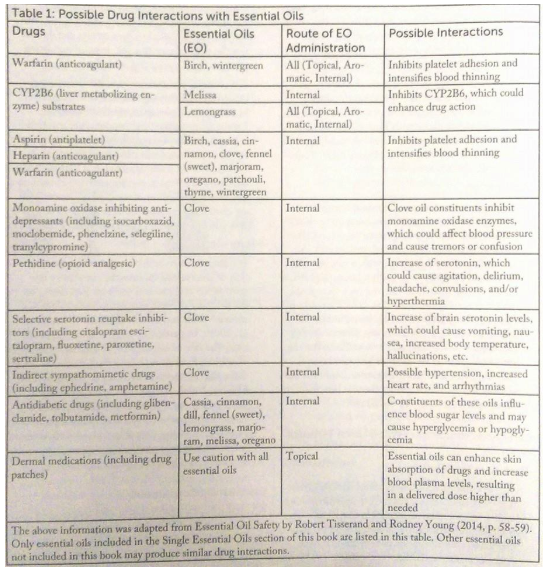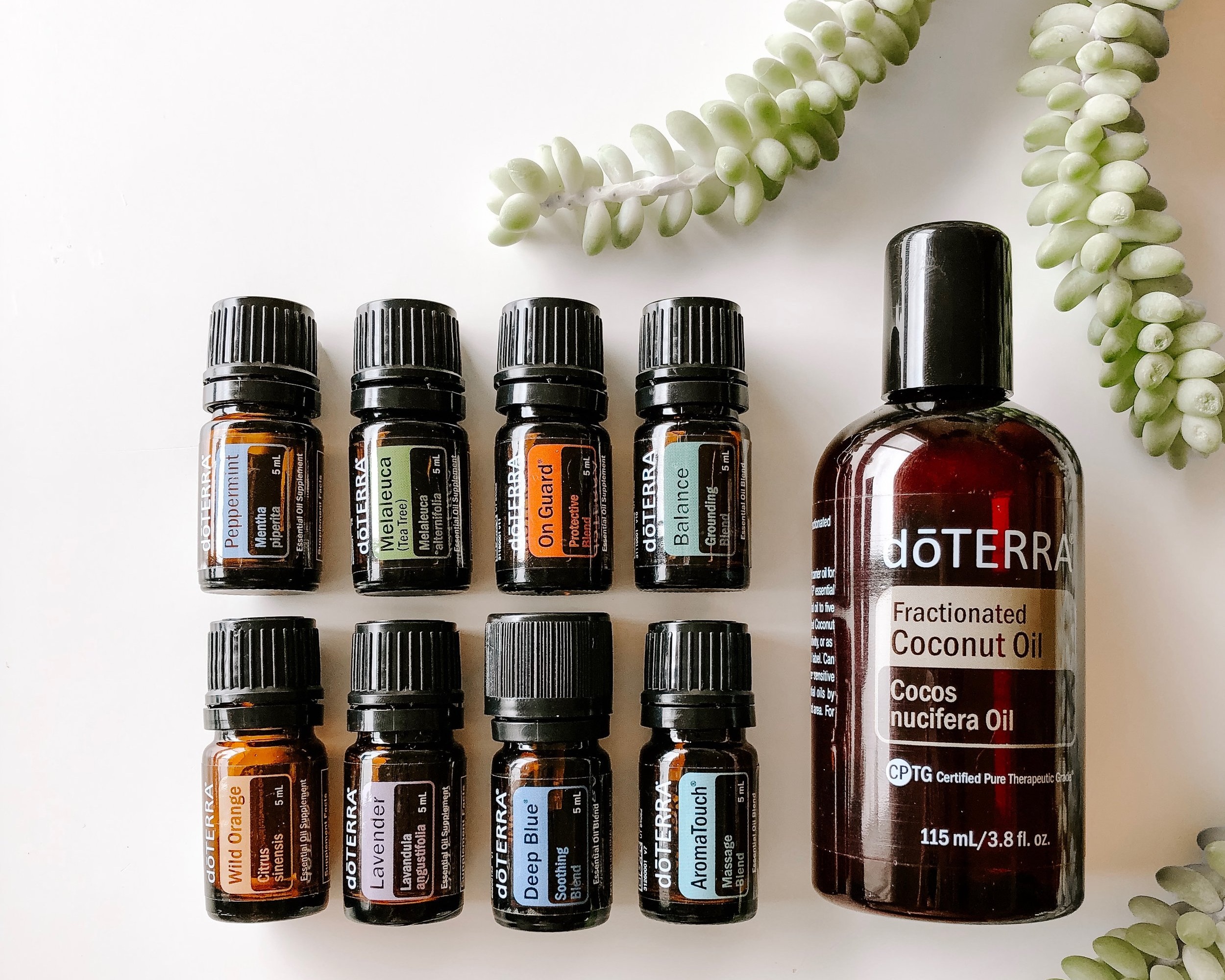the hol:fit
OIL SAFETY kit
In this guide, you’ll learn how to safely use doterra …
All of the information provided in this guide is recommended only when using doTERRA essential oils,
the most pure, most trusted and most tested brand in the world.
You will often come across posts online or information from aromatherapists that create fear around using essential oils. For decades - there was not a lot of research on essential oils or data collected on usage outcomes. There is also no governing body protecting the consumer from what might be in that bottle of essential oil they just purchased. This is why doTERRA’s CPTG stamp is so important. It’s doTERRA’s commitment to purity. One other important note - doTERRA has almost 6 million essential oil users around the world. This creates the largest database of usage information available …
Here is an excerpt from our Supernatural Recipe Guide which covers the main safety points:
Let’s begin by hearing from a Medical Doctor that uses doTERRA essential oils in + out of his practice:
CERTIFIED PURE TESTED GRADE
doTERRA CPTG essential oils can be used safely by your family for a variety of wellness applications.
However, there are several safety guidelines that you should follow when using essential oils (EO) and EO products.
Be sure to use only pure, therapeutic-grade essential oils and follow all label warnings and instructions.
If redness or irritation occurs when using essential oils topically, apply a carrier oil - such as fractionated coconut oil or olive oil - to the affected area.
Do NOT use water (this will drive the EO further).
Essential oils should not be used in the eyes, inside the ear canal, or in open wounds. In the event of accidental contact with the eye, dilute with carrier oil NOT water.
Discontinue the use of an EO if you experience severe skin/stomach/respiratory irritation or discomfort.
When using on children, apply a very small amount of the oil to test skin or other sensitivity. Do not use oil on a child's hand as they may transfer to their eyes or mouth.
Consult your physician before using EO if you are pregnant or under a doctor's care or have other safety questions regarding EO
It is important to remember that therapeutic-grade essential oils are highly-concentrated plant extracts and should be used with reasonable care.
Consulting with someone who has experience with EO will make your first experience with more enjoyable and rewarding. As you learn how to use oils through personal experience, share your knowledge with others in a safe and responsible way and encourage others to do the same
APPLICATIONS
+ METHODS OF USE
3 Ways to Use Oils
Essential oils are used for a wide range of emotional and physical wellness applications.
They can be used a single oil at a time or in complex blends in one of three methods: Aromatic, Topical and Internal.
Aromatic and Topical application are always the first line of defense and most effective way to derive the therapeutic benefits from the essential oils.
Internal ingestion of oils should be done carefully, with caution, after familiarizing yourself with safe practices.
First, here is a helpful chart of daily ideal amounts with your oils:
And here are charts of all doTERRA Oils showing which of the 3 ways each oil can be used:
Aromatic
Essential oils, when diffused, can be very stimulating, while others can be calming and soothing.
Diffusing essential oils can also cleanse and purify the air. Low or no-heat essential oil diffusers are recommended as they do not change the chemical structure of the oil being diffused. Diffusers manufactured for use with essential oils emit a cool mist (they do not heat up the oils). Humidifiers and other similar devices are not intended for use with essential oils and the oils may damage the components of that machine. Most diffusers come with instructions indicating how many drops of oil should be use … the typical amount ranges from 2-3 drops for a small diffuser to 6-8 drops for a diffuser with a large reservoir.
Topical
Essential oils are easily absorbed by the skin and many can be safely applied topically when used in conjunction with a carrier oil, such as Fractionated Coconut Oil. Topical application of essential oils can have immediate, localized benefit to the target area of application. The chemical structure of essential oils also allows them to be absorbed into the bloodstream via the skin for internal benefit throughout the body. Oils should typically be diluted with a carrier oil prior to applying to the skin.
Before applying the oil to sensitive skin or children’s skin first perform a “Skin patch test”: apply the diluted essential oil (dilute at 5% with carrier oil) and dab a small amount on a small patch of skin.
Watch for redness, irritation, itching, swelling- if irritation occurs, do not use that oil. A mild reaction will resolve on its own quickly.
Baths: Putting essential oils into the bath without first mixing it with a carrier oil or dispersing agent can lead to a risk in skin irritation. You will want to mix your essential oil with a carrier oil, full-fat milk, or epsom salts before adding to the bath water.
Photosensitivity: Skin should not be exposed to sunlight or tanning beds for 12-18 hours, if any of the following oils are used: Citrus Oils- Lemon, Lime, Grapefruit, Bergamot, Wild Orange.
Internal
You will want to begin with topical and aromatic usage of oils to become comfortable with them and then explore internal use.
The importance of doing your research and reading everything available on this topic cannot be stressed enough. Empower yourself to make an informed decision.
If and when you do decide to use oils internally, remember that less is always more.
Diluting
Essential oils
Benefits of Diluting Essential Oils
Using a carrier oil to dilute the essential oil increases the surface absorption, enhances absorption through dry skin, and prevents skin sensitivities. To dilute an essential oil you add it to a “carrier” or “base” oil. Determining when and how to dilute is a personal decision that should be based on usage preferences, oil chemistry, and personal sensitivity. Use the “Essential Oil Dilutions” charts below as guidelines.
What is a carrier oil?
A lipid-based substance such fractionated coconut oil & pure vegetable oils- grapeseed, almond, avocado, etc. Vegetable oils are unstable and go rancid quite easily. Fractionated Coconut Oil is prefered because it is stable at all room temperatures and environments, it is non-aromatic, and therefore does not alter the aromatic properties of essential oils. See list of carrier oils here.
{References: Dr. Hill on Carrier Oils}
As your body becomes familiar with essential oils - you may wish to increase the amount of drops you use until you achieve the desired results. But always start on the low end
Here is a safe, diluted approach when you are just getting started with essential oils:
Guidelines for topical use when first starting out:
NOTES FROM CHART:
EO = essential oil
Carrier = the bottle size or carrier oil amount.
After 2 weeks of using essential oils with no issue (ie. skin sensitivity) you can increase as per the chart
INGESTING
ESSENTIAL OILS
Certain essential oils have a rich culinary history and can be used as dietary supplements supporting a variety of healthy conditions. Some essential oils have powerful antioxidant properties while others help support healthy inflammatory response in cells. Many essential oils are generally regarded as being safe for dietary use, but some oils should not be taken internally.
Oils that are not Certified Pure Therapeutic Grade should not be ingested.
CHILDREN under 6 and/or less than 44b (20kg) should not take essential oils internally.
Best Method of Ingesting
In order to avoid gastric irritation, orally ingested essential oils should be placed in a enterically coated capsule that is stomach acid resistant. Also, the oil should first be diluted in a carrier oil and then placed inside the gel capsule with the appropriate amount of mixture. You will see many casual users discourage this suggestion, but for best practices, this is the preferred method.
How Much is Enough?
All sources suggest that less is more when it comes to the internal use of essential oils.
When using essential oils internally, it is important to regard them with as much precaution as any other supplement. It is best to start with the lowest possible dose (1–2 drops) and then increase the dose as needed.
After a certain point, taking a higher dose no longer adds benefit.
It is better to take a smaller dose, which can be repeated every 4–6 hours as needed.
In total, typically no more than 24 drops, divided into doses, should be consumed in a 24-hour period.
The maximum dose may be lower or higher for some oils. If you consume near the maximum dose, you should not continue with that dose for an extended period of time. A lower daily dose is recommended for extended internal use.
If a higher dose is desired, it should be taken only under the observation of a physician to ensure that no harm is occurring.
Most essential oils are very safe when used internally, but it is important to be aware of proper dosage protocols. The effective internal dose and frequency is dependent on many factors that vary widely from person to person.
The necessary dose may change based on the age, size, and health status of the person, as well as their desired health benefit.
Essential Oils
And Kids
Among the greatest attributes of essential oils is that their safety and benefits extend to all members of the family—no one is excluded, even young children and infants. Because of their potency, you will find that essential oils are capable of offering immediate benefits and relief to your child. For the same reason, a very low dose is all that is needed to induce powerful therapeutic effects. Topical application is perhaps the most controlled method for administering essential oils to children because it allows for treatment of targeted concerns. Some oils can be sensitive to the skin and should be diluted with Fractionated Coconut Oil before applying topically. Another effective mode of administration is diffusion, which is simple to integrate into your family’s health regimen. Consistent use of essential oils is a safe yet effective method for your family’s health. More here.
Topical & Aromatic applications will be the most effective application method for children. Do not allow your children under age 6 to ingest oils.
Most common topical application area for oils are on the bottoms of the feet, back of neck, and/or spine. ALWAYS dilute oils before applying to children.
Skin Patch test: Be sure to do the skin patch test on a small area of skin to see if the skin reacts prior to applying oil to larger areas of the body.
DO NOT apply essential oils on children’s faces or hands to avoid the oils getting into their eyes.
Store oils out of children’s reach. While a drop is not likely harmful to them, drinking an entire bottle would be lethal. Keep them in a safe place out of reach.
Never put oils in ears, eyes, or nose.
If putting an oil into the child’s bath, be sure to only use 1-3 drops and dilute them into a carrier oil or into epsom salts before adding to the bath water.
ESSENTIAL OILS AND PREGNANCY
Resources on Essential Oil Use During Pregnancy:
Oil Protocols and safety info for pregnancy
Oil Protocols and info for Breastfeeding
Pregnancy Guidelines from the International Federation of Professional Aromatherapists
Select "Pregnancy Safety"- National Association for Holistic Aromatherapy
Book: Essential oils for Pregnancy, Birth & Babies- Stephanie Fritz (The Essential Midwife) and this Webinar by Stephanie Fritz
Note: The use of essential oils during pregnancy is a controversial topic and is not fully understood. Some proponents argue most essential oils are safe while pregnant, while others say that only a select few oils are safe. Some say to avoid essential oils completely while pregnant just to be cautious leaving consumers confused. There are benefits of using essential oils while pregnant, to relieve tension, aches, and stress and many women can attest to this.. With all this in mind, do your research, read, read, and read some more, and make the best informed decision for yourself.
ChildBirth
There is no evidence that any essential oils have adverse effects when used to ease pain or anxiety during childbirth.
Oils to be avoided one week before & after childbirth because they affect blood coagulation are: Birch (sweet) + Wintergreen.
Some women have found that Peppermint oil decreased their milk supply … this is helpful to know when weaning, but something to be mindful of in your 3rd trimester
Also, Clary Sage can be helpful for stimulating contractions if you are overdue.
MEDICATIONS AND CONDITIONS
If ever in doubt whether an essential oil is contraindicated for a medication you take or medical condition you have, please contact your physician, pharmacist or naturopathic doctor for direction.
Anti-coagulants
These are the essential oils that are known to, or are very likely to, inhibit blood coagulation through ORAL administration: Wintergreen (contains methyl salicylate which are biologically similar to the constituents in aspirin, which is the active ingredient)
Caution is advised if taking an anticoagulant drug such as: aspirin, heparin, and warfarin.
Caution is advised if breastfeeding, have a peptic ulcer, hemophilia, internal bleeding, hepatic or renal impairment, hypertensive or diabetic retinopathy, have a decreased platelet count, have vasculitis, or are up to one week before or after major surgery or childbirth.
Diabetes
Because of essential oils effects on blood sugar, some essential oils may interact with diabetic medication (glibenclamide, tolbutamide, metformin) if taken in ORAL doses.
The constituents of these oils influence blood sugar levels and may cause hyperglycemia or hypoglycemia:
Remember, this is if taken ORALLY: Anise, Cassia, Cinnamon Bark, Dill, Fennel, Geranium, Lemongrass, Marjoram, Melissa, Oregano
Diuretics
Because of it's antidiuretic action, anise oil may interact with diuretic medication (bendrofluazide, furosemide, spironolactone) if taken in oral doses.
A note about Grapefruit Oil
There is some research that says you should avoid Grapefruit if you suffer from or are taking medications for high blood pressure. Often physician’s will advise their patients to avoid grapefruit for this reason. The compounds of concern are present in the meat of the fruit and are not present in Grapefruit essential oil, which come from the rind or peel of the fruit. Citrus oils, specifically Grapefruit, have been used for quite some time without any regards to there being any detrimental effects even with high blood pressure. It can be stabilizing to the body.
That being said, if someone has very direct concerns encourage them to consult with their physician and address that question with them.
Epilepsy
Some essential oils, if taken ORALLY, should be avoided if you are prone to seizures. However, people who are taking suppressant medication may be no more vulnerable than non-epileptics.
Epileptics who are not on medication are vulnerable, as are people who do not realize they are epileptics, and also infants and children.
The essential oils listed below are the oils that could pose potential problems. They should only be used up to the recommended maximum amounts, which are intended to be safe for the general use, including people who might be prone to seizures.
ALL of these have a safe dermal dosage (topical) but NOT all of these are safe to take INTERNALLY: Rosemary, Arborvitae and Wintergreen
Warfarin
If you are taking Warfarin or any of its brand names, then you will want to make sure you avoid ORAL use of Wintergreen or Birch essential oil.
The following essential oils are cautioned against if you are taking Warfarin : Anise, Basil, Cassia, Cinnamon Bark, Clove bud, Fennel, Marjoram (wild), Oregano, Patchouli, Thyme
Possible Drug Interactions with Essential Oils
Reference: Aroma Tools (2004), Modern Essentials *6th Edition* a Contemporary Guide to the Therapeutic Use of Essential Oils.
ESSENTIAL OILS
AND PETS
With pets ... ultimately, you will hear many things from many people about safety.
Almost all doterra oils are safe to use around + on your pets.
Cats specifically lack an enzyme called glucuronyl transferase.
This makes cats very susceptible to ALL kinds of toxicity, including plant, NSAIDS (like aspirin, ibuprofen and Tylenol), chocolate and caffeine (methylxanthines), lead, zinc, and many, many types of pesticides.
So which oils do you stay away from? Most medical grade oils are so pure that you can use them topically on cats sporadically in a highly diluted form (as if for infants).
It's not a good idea to use them topically or internally on your cat every single day (with the exception of helichrysum, myrrh, lavender and Frankincense).
*The oils to stay away from and use something different if you can are the oils that are high in phenols ketones as far as direct application (topical or internal) to your cat (basil, birch, cinnamon, clove, fennel, melaleuca, oregano, peppermint, thyme, rosemary, spearmint, and wintergreen.)
They are also sensitive to d-limonene containing oils (bergamot, dill, grapefruit, lemon, lime, orange, and tangerine).*
That being said, I have used even medical grade Melaleuca on my own cat without dilution without any ill effects. Just like people, every individual animal is different and you should consult your veterinarian if you are concerned and get some bloodwork to ensure no underlying liver disease.
There are many ways to use essential oils with cats - my preference is water diffusion. You can also make a litter box powder with essential oils by using 1 cup of baking soda and 3-4 drops of an essential oil of your choice, stirring well and letting it sit overnight (to saturate the baking soda with the oils) and then sprinkling this on your cat's litter (You do not have to use the full cup, just enough to cover the litter). You can also apply the oils topically (I recommend dilution for this - 1 drop in a tsp to a tbsp of carrier oil and using a drop of that mixture) - the easiest way to topically apply essential oils to cats is simply by petting along the spine. It is the best tolerated. You can also use the reflexology points or rub the tips of the ears, if your cat is more agreeable to these applications. The cat will ingest these oils via grooming when applied topically, which is why dilution is recommended. You can also apply essential oils to cats by giving it internally. Start with just a toothpick drop of the oil, and mixing it with wet food. Some cats are very picky eaters and will not eat their food if there is an oil in it, others don't seem to mind it at all. Just observe your cats behavior and they will tell you what works best for them.
As far as diffusion goes - I diffuse everything (yes, even those oils that are high in phenols and citrus oils)! i just make sure not to diffuse anything in my kitty's room (where her food and litter box are) and make sure she's not "locked" in the room with the diffuser - she will go away if it's one she doesn't like or need. I find that most often, though, she needs the oil I'm diffusing as much as I do, and sleeps as close as she can to the diffuser. The Protective Blend is one of her favourites!
The "Take Home" message is this: don't give oils to cats topically or internally *every* day (with some exceptions), dilute them, only use medical grade quality (and tested) oils
A great resource is Dr Janet Rourk, The Essential Vet
ADDITIONAL INFORMATION & RESOURCES
References:
Schnaubelt, Kurt. The Healing Intelligence of Essential Oils
Schnaubelt, Kurt. Medical Aromatherapy
Schnaubelt, Kurt. Advanced Aromatherapy
Tisserand, Robert and Young, Rodney. Essential Oil Safety
Module 5 on Safety in doTERRA University
Modern Essentials *6th Edition* a Contemporary Guide to the Therapeutic Use of Essential Oils (The NEW 6th Edition)
The Essential Life Book
Tisserand Institute.com
Additional Resources:
Essential Oil Myths, Dr. Pappas here
Proper Care in Using Essential Oils here
Oil Storage Tips- Use glass or high grade plastics (see here for details)
Safety Guidelines for Essential Oils here
International Journal of Childbirth Education
A great blog post by Jade Shutes from the NAHA on the importance of balancing research with personal experience


